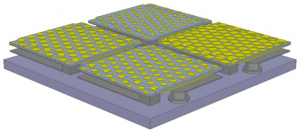March 30, 2021

This graphic shows four different metasurface integrated microbolometers with different response.
A Mizzou Engineer and collaborator at the University of Notre Dame have received a grant from the Army Research Office to enable a new generation of multispectral infrared (IR) imagers.
Mahmoud Almasri, an associate professor of electrical engineering and computer science (EECS), is working with Edward Kinzel, an associate professor of aerospace and mechanical engineering at UND and an adjunct faculty member of EECS at Mizzou.
Many animals (including people) have trichromatic vision at optical wavelengths. Three broadband color channels are interpreted by our brains to provide a rich gambit of color information about the world. This allows us and similar creatures to recognize predators and prey in camouflage, identify ripe fruit, and better perceive our environment. A counter example is deer that cannot resolve hunters wearing blaze orange vests.
This concept can be applied to the thermal infrared. Room temperature objects emit radiation at these wavelengths (8-14 µm). The mid-infrared is also sometimes called the molecular fingerprint region and is used for spectroscopy. This is exploited by conventional IR hyperspectral cameras. These require power for moving parts and cooling, which result in bulky expensive devices. On the other hand, thermal cameras using microbolometers, provide uncooled, low-cost infrared imaging. They are widely used in commercial and defense applications. However, microbolometers are generally engineered with broadband infrared absorptance which removes spectral selectivity.
The $480,000 research grant will allow the team to investigate integrating metasurfaces with microbolometers. Metasurfaces are 2D networks of antenna elements that allow the impedance of a structure to be engineered. This includes creating spectral and polarization selectivity. When a temperature sensitive material is integrated into the metasurface, the resulting microbolometer pixel has geometry dependent infrared absorptance, thermal response and electrical performance in addition to fabrication cost. The objective of the research is establish these relationships and enable a new generation multispectral IR imagers.
“Encouraging preliminary results suggest that high performance, multispectral microbolometers can be created using the metasurface to simultaneously provide wavelength selectivity and improve the electrical performance of the device,” Almasri said.
The resulting low-cost microbolometers can be combined with machine learning to provide chromatic images analogous to what we enjoy in the visible. This will enable a broad range of military applications in areas such as defeat camouflage, discriminate between natural and manmade surfaces, surveying a battlefield to inspect for the use of chemical weapons or explosives before exposing US troops.
Potential platforms include helmet-mounted sights, unmanned aerial vehicles, robots, and driver’s aids for military vehicles.